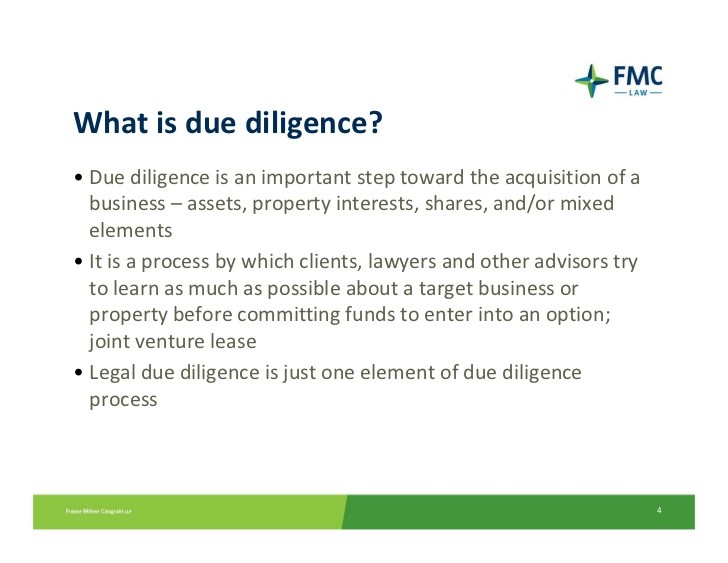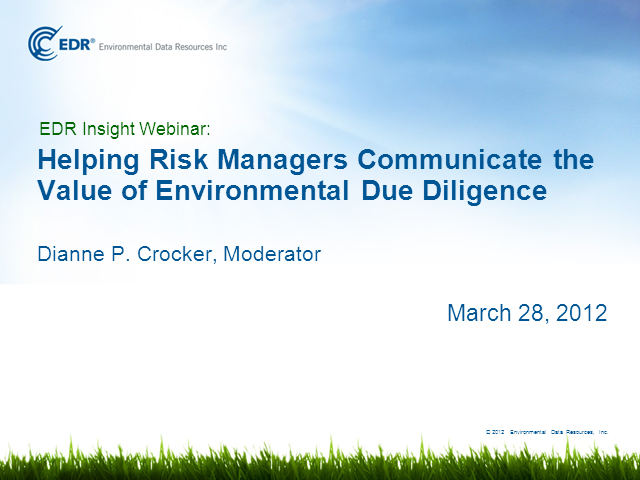Environmental Due Diligence Ten Key Steps
Post on: 30 Апрель, 2015 No Comment

Environmental Due Diligence
December 2003
for New Hampshire Business Review
Ten key steps in addressing environmental concerns in real estate transactions
The transaction is conceived. The basic terms are negotiated. The agreement is drafted. The parties sign. Its time for the buyer to focus attention on the closing, right? Wrong. The often neglected due-diligence period comes first and using it effectively can save you from expensive mistakes.
Whether your transaction is a multi-property mega-deal or a small, single-parcel closing, the due-diligence period is a critically important opportunity for buyers to identify and evaluate potential environmental concerns and expenses. Once your evaluation is complete, the due-diligence period provides a last opportunity to make accommodations, discuss price reductions or, in some cases, reject the transaction.
Here are 10 suggestions for getting the most out of your hard-earned due-diligence opportunity:
1. Organize your due-diligence team early: Negotiating the duration of a due-diligence period often is a central issue in crafting a transaction. The seller wants to close yesterday. The buyer doesnt want to waste time, but needs an opportunity to identify issues and evaluate risk. Having your diligence team assembled early in the project and ready for action can make all the difference in collecting relevant data and making informed decisions before the last-minute crunch.
2. Include environmental consultants on your due-diligence team: Hiring consultants at the time you form your diligence group will help ensure that a well-rounded team is ready to hit the ground running. Moreover, negotiating consulting contracts and tailoring and the specifics of confidentiality agreements are important considerations that demand reasonable care. The best time to work out these peripheral matters is before your diligence clock starts ticking.
3. Quickly assess the adequacy of existing reporting: Both sophisticated and unsophisticated sellers often do not provide all detailed information and reporting regarding known environmental issues. Qualified consultants can quickly identify missing information or identify data gaps where additional materials are needed for a more complete understanding of the property. Depending on the scope of the issues reported and the nature of any remedial activities, consultants can use available reports to make an initial assessment of risk and liability. Using qualified environmental consultants to sort through what is provided and to help focus your diligence team on these and other environmental matters or on unknown conditions is critical.
4. Search regulatory databases for known environmental issues: Nearly all federal and state regulatory agencies maintain updated property databases, including comprehensive information about environmental permitting, existing conditions or contamination and past remedial activities. Having your environmental consultants review these databases can provide a quick baseline of data to organize further inquiries and avoid duplication of available information.
5. Organize Phase I or invasive investigations early: A Phase I investigation, including a review of existing information supplied by the seller and available from regulatory agencies, is a standard ingredient in any real estate transaction and serves to identify issues and the need for more invasive investigations. Scheduling your Phase I and collecting available data early allows for sufficient time to organize any further investigation, including soil and ground water testing, analyze results and estimate risk and potential liabilities within your short diligence window.
6. Examine permits and licenses for future land uses or operations: Environmental permits and licenses are valuable and often transferable commodities. However, the effectiveness of transferring such permits or licenses needs to be measured against the future or anticipated uses of the real estate. In addition, the capacity of such permits or licenses to accommodate expansion should be evaluated. For example, a buyer who plans to expand an industrial land use should determine if existing permits contain sufficient excess capacity to allow for increased emissions, discharges or other anticipated impacts. Whether to expand permit capacities or invest in capital improvements to comply with existing limitations are important considerations in closing the deal.

7. Identify new or proposed regulatory compliance requirements: Depending on a buyers future use of the property, new or proposed regulatory requirements may affect operations. Regulatory changes can affect a range of issues ranging from daily discharges, emissions from operations or the methods or quality of necessary environmental remediations. A diligence teams search for and evaluation of such potential regulations can help buyers make informed decisions about the costs of future operations and compliance measures.
8. Explore insurance options: The environmental insurance market offers a variety of cost-effective risk management tools. These policies often can be extremely useful in addressing liability risks identified during due diligence and in facilitating the completion of otherwise advantageous transactions. Retaining a qualified environmental insurance broker to provide an understanding of available insurance products, estimate premiums and help with the negotiation of insurance terms and conditions frequently can provide a basis for an impaired or fragile transaction to close.
9. Explore escrows and indemnities: Sellers pushing toward a closing have invested substantial resources in preparing assets for sale, locating buyers and assembling transactional teams. Buyers who properly identify and evaluate potential or known environmental risks have substantial leverage in negotiating favorable escrow mechanisms or valuable indemnity protections. Often such escrows or indemnities can supplement insurance options and allow a transaction to close.
10. Establish a post-closing implementation and monitoring team: After the transaction closes and the buyer takes control, many of the concerns addressed or accommodated during the due-diligence period will enter an implementation stage. Having the proper personnel and/or consultants remain involved in the transaction to manage and operate implementation and monitor escrow arrangements or indemnity protections is an important final stage to any transaction.
By preparing for and conducting an organized and thorough due-diligence investigation, buyers can better prepare for evaluating future liabilities and expenses, negotiate more favorable pricing terms and manage risks on a going forward basis.
*Ari B. Pollack is admitted in New Hampshire and Massachusetts.
Return to Resources index














